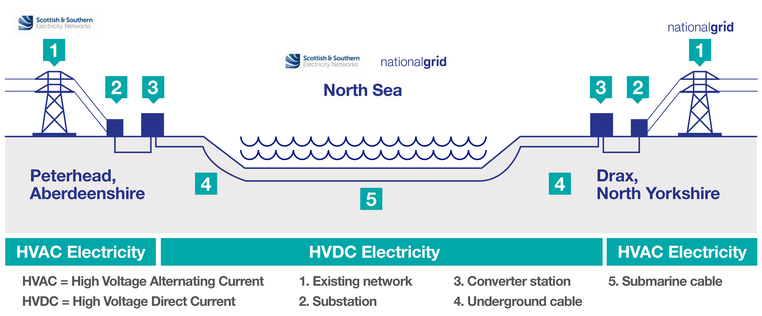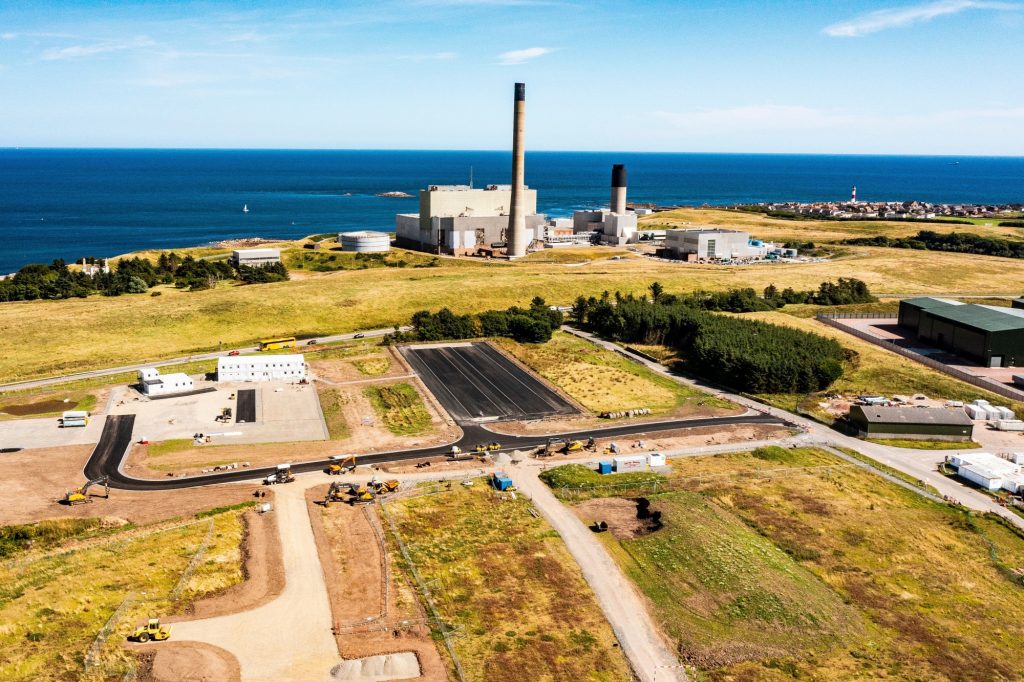Ground broken on construction of £4.3bn England

This post was originally published on this site
Construction on the £4.3bn Eastern Green Link 2 (EGL2) offshore interconnector between England and Scotland in has begun with a groundbreaking ceremony at either end of the planned 506km “electricity superhighway”.
EGL2, when completed, will be a 525kV, 2GW high voltage direct current (HVDC) subsea transmission cable from Peterhead in Scotland to Drax in England. It is being delivered as a joint venture by National Grid Electricity Transmission and SSEN Transmission.
The project will see the longest HVDC cable in the UK and will be the UK’s single largest electricity transmission project constructed. In August, Ofgem approved £3.4bn of public funding for the England to Scotland offshore HVDC link marking the UK’s single largest electricity transmission project ever.
Construction work on the project took a major step on Thursday, 26 September with the symbolic simultaneous ground-breaking ceremony at either end of the planned cable.
After travelling 436km southwards under the sea from Peterhead, EGL2’s subsea cable will come ashore on the East Yorkshire coast at Fraisthorpe Sands and then run underground for 68km to a new HVDC converter station at Drax.

How EGL2 will work
In March, Bam-Hitachi Energy joint venture was appointed to build the converter stations for the link.
Wren Hall Converter Station in Drax has seen the start of main construction activities this month, including site establishment and vegetation clearance. Surveys are expected to continue along the underground cable route in the coming months.
The overall project is expected to be operational in 2029.
National Grid offshore delivery director Zac Richardson said: “Today marks an important moment for all involved in the project and the commitment of both National Grid and SSEN in delivering major projects that will play a key role in supporting the UK’s transition to a net zero economy.
“EGL2 is the first of four currently proposed 2GW projects between Scotland and England to begin construction and in total these projects, delivered in partnership by National Grid, could provide enough renewable electricity to power eight million homes.
“Achieving this first milestone wouldn’t have been possible without the huge commitment of the project team, our construction partners, stakeholders and the invaluable feedback from local communities.”
Ofgem director general for infrastructure group Akshay Kaul said: “Today is a historic occasion.
“Not only is construction starting on EGL2, Britain’s biggest ever electricity transmission project, but we’re also standing here two years earlier than we might have been thanks to Ofgem’s fast track new process which cuts red tape to get consumers across the country connected to renewable energy more quickly.
“Harnessing homegrown clean energy will help build a secure energy future for Britain, and projects like EGL2 are pivotal in our move towards that.
“This is the first project to successfully complete our new process and many more major energy projects are going through this fast-track pipeline.
“Our involvement with EGL2 doesn’t end here we stand poised to step in if needed to ensure maximise efficiency and consumer benefit.”
Progress of other major GB interconnectors
EGL2 is the first of four currently proposed 2GW projects between Scotland and England to begin construction delivered in partnership by National Grid.
The other three projects are Eastern Green Link 1 (EGL1), a joint venture in partnership with SP Energy Networks, Eastern Green Link 3 (EGL3), a joint venture in partnership with SSEN Transmission, and Eastern Green Link 4 (EGL4), a joint venture in partnership with SP Energy Networks.
It was announced earlier in the year, EGL1 would be the first project to proceed under a new Ofgem fast track process and would receive a provisional £2bn funding package.
The joint venture behind EGL1 project handed out £1.8bn worth of contracts to build the project in December last year. The Prysmian Group was awarded a £750M contract to deliver the UK’s first 525kV high voltage direct current (HVDC) electricity transmission cable as part of the project while GE Vernova Grid Solutions and Mytilineos Energy & Metals was awarded a £1bn contract to supply and construct two HVDC converter stations, one at each end of the link.
In February, Mott MacDonald was appointed by National Grid to provide front end engineering design (Feed) and technical support for the EGL 3 and 4 interconnector projects and then in April, early proposed designs of both projects were put up for public consultation.
All of the Eastern Green Link projects are part of National Grid’s Great Grid Upgrade, a series of interlinked projects to support up to 50GW of offshore wind capacity by 2030 as part of the UK’s vision for a net zero future. NCE recently spoke to National Grid president for strategic infrastructure Carl Trowell about the challenges of delivering this project.
Like what you’ve read? To receive New Civil Engineer’s daily and weekly newsletters click here.





Responses